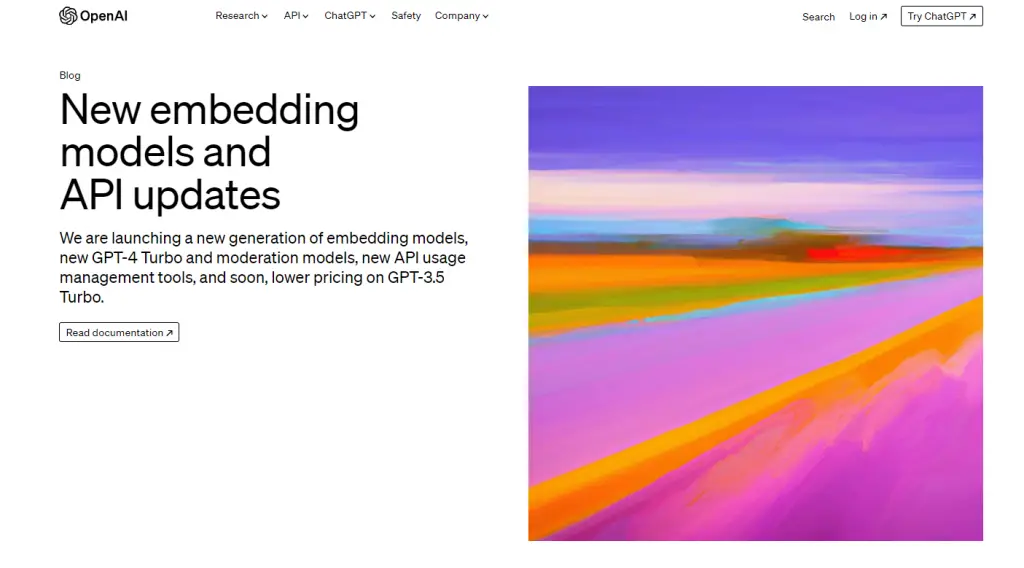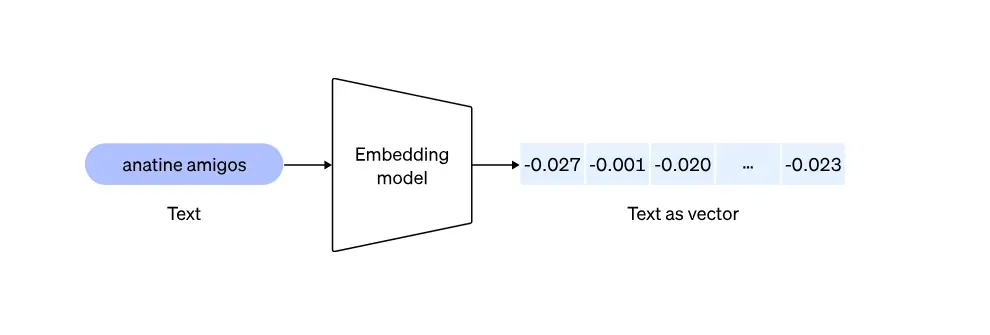New OpenAI Embedding Models: A Giant Leap in AI Efficiency and Accuracy

In an era where AI tools are not just augmenting but revolutionizing every aspect of our digital lives, OpenAI’s latest innovation, the new embedding models, stand out as a beacon of advancement. These models, text-embedding-3-small and text-embedding-3-large, are redefining the landscape of natural language processing, offering unprecedented efficiency, accuracy, and versatility. From enhancing search engine capabilities to transforming recommendation systems, and from facilitating advanced natural language processing to driving ethical AI development, these tools are setting new benchmarks in the AI domain.
OpenAI’s new embedding models, text-embedding-3-small and text-embedding-3-large, are transforming the AI landscape with their enhanced performance, efficiency, and versatility.
Table of Contents
New OpenAI Embedding Models Have Arrived
The AI landscape has reached a new milestone with the arrival of OpenAI’s latest embedding models: text-embedding-3-small and text-embedding-3-large. These models represent a significant leap forward in natural language processing capabilities. They are designed to provide more accurate, efficient, and nuanced understanding of text, setting new standards in the field. The introduction of these models marks a pivotal moment in AI development, offering enhanced performance and versatility compared to their predecessors.
OpenAI’s new embedding models are not just incremental updates; they are substantial upgrades that redefine the efficiency and effectiveness of language processing. The text-embedding-3-small model, known for its compactness and efficiency, offers a significant performance boost over the previous generation, making it an ideal choice for applications requiring speed and cost-effectiveness. On the other hand, the text-embedding-3-large model, with its increased dimensionality, provides deeper and more detailed text analysis, suitable for complex language tasks. Together, these models open up new possibilities for developers and researchers in various fields.

What are New OpenAI Embedding Models?
OpenAI’s new embedding models, text-embedding-3-small and text-embedding-3-large, are advanced tools designed to transform text into numerical representations, making it easier for machines to understand, process, and analyze language. Embeddings are fundamental in various AI applications, including natural language processing, where they help in tasks like text classification, sentiment analysis, and language translation. These models convert text into a sequence of numbers, capturing the essence and context of the language in a form that AI systems can effectively utilize.
The text-embedding-3-small model is a more compact and efficient version, offering improved performance at a lower computational cost. It’s particularly suited for applications where speed and efficiency are crucial. The text-embedding-3-large model, on the other hand, provides a more comprehensive and detailed analysis of text through its larger dimensionality, making it ideal for complex tasks that require a deeper understanding of language nuances. Both models are trained to handle multiple languages, making them versatile tools for global applications. Their introduction signifies a major advancement in the way AI systems interact with and understand human language.
Also read:OpenAI’s Suspension of Developer for ChatGPT Bot in Political Campaign

Features & Benefits of New OpenAI Embedding Models
Enhanced Performance and Accuracy
- Improved Benchmark Scores: Both models show remarkable improvements in standard benchmarks like MIRACL and MTEB, indicating superior language understanding.
- Multi-Language Support: Enhanced capabilities in processing and understanding multiple languages, making them versatile for global applications.
- Greater Contextual Understanding: Advanced algorithms allow for a deeper understanding of context, essential for nuanced language tasks.
Cost-Effective and Efficient
- Reduced Pricing: The new pricing strategy makes these models more affordable, especially for startups and individual developers.
- Energy Efficiency: Designed with efficiency in mind, these models require less computational power, contributing to a greener tech environment.
- Time-Saving: Faster processing speeds lead to reduced development time and quicker deployment of AI applications.
Scalability and Flexibility
- Adaptable to Various Applications: Whether it’s for search engines, recommendation systems, or data analysis, these models adapt seamlessly.
- Customizable Embedding Sizes: Developers can adjust embedding sizes to suit their specific needs, balancing performance and resource usage.
- Integration-Friendly: Easy integration with existing systems and platforms, making them a versatile tool for developers.
Advanced Security and Privacy Features
- Enhanced Data Privacy: Commitment to user privacy with robust data handling and processing protocols.
- Secure API Usage: Advanced security measures in API interactions, safeguarding against unauthorized access.
- Transparency in Data Usage: Clear policies on how data is used, providing users with peace of mind regarding their information.
Continuous Improvement and Support
- Regular Updates: Ongoing updates to the models ensure they stay current with the latest advancements in AI.
- Community and Developer Support: A strong support system for developers, including documentation, forums, and direct assistance.
- Feedback-Driven Development: OpenAI’s approach to incorporating user feedback ensures that the models evolve to meet real-world needs.

The Functional Details of New OpenAI Embedding Models
text-embedding-3-small: Compact Efficiency
The text-embedding-3-small model is a testament to efficiency and compact design in AI. Tailored for applications where speed and resource management are crucial, this model offers a significant upgrade over its predecessor.
- High Efficiency: Optimized for rapid processing, making it ideal for real-time applications.
- Cost-Effectiveness: Reduced pricing makes it accessible for startups and individual developers.
- Compact Design: Smaller in size, yet powerful in performance, suitable for environments with limited computational resources.
- Improved Accuracy: Enhanced precision in language understanding, particularly beneficial for applications like chatbots and customer service automation.
- Multi-Language Capability: Capable of handling multiple languages, making it versatile for global applications.
text-embedding-3-large: Advanced and Comprehensive
The text-embedding-3-large model represents the next generation of embedding technology, offering advanced capabilities for complex language tasks.
- Deep Language Understanding: With up to 3072 dimensions, it provides nuanced and detailed text analysis.
- Versatility in Application: Ideal for sophisticated NLP tasks like sentiment analysis, language translation, and content summarization.
- High Performance: Outperforms previous models in benchmarks, making it suitable for research and development in AI.
- Scalability: Capable of handling large volumes of data, perfect for enterprise-level applications.
- Multidimensional Analysis: Its large dimensionality allows for a deeper understanding of context and subtleties in language.

The Use Case of New OpenAI Embedding Models
Enhancing Search Engine Capabilities
The new OpenAI embedding models significantly improve search engine functionality. By accurately understanding and processing user queries, these models can deliver more relevant and precise search results. They excel in comprehending the context and nuances of search terms, leading to a more intuitive and efficient search experience. This capability is particularly beneficial for specialized search engines in academic, legal, or medical fields, where accuracy and context are paramount.
Transforming Recommendation Systems
OpenAI’s embedding models are game-changers for recommendation systems. They analyze user preferences and content features with a high degree of accuracy, enabling more personalized and relevant suggestions. Whether it’s for e-commerce, content streaming, or social media platforms, these models can significantly enhance user experience by accurately predicting and recommending products, movies, or articles that align with individual tastes and interests.
Facilitating Advanced Natural Language Processing
These models are pivotal in advancing NLP tasks like sentiment analysis, language translation, and text summarization. They provide a deeper understanding of linguistic structures, making it possible to accurately interpret emotions, translate languages while maintaining context, and summarize large texts without losing essential information. This advancement is particularly beneficial for customer service automation, cross-language communication, and information extraction from large datasets.
Revolutionizing AI with OpenAI's Embedding Models
Accelerating AI Research
OpenAI’s new embedding models are accelerating AI research by providing more accurate and efficient tools for language understanding. Researchers can now process and analyze large volumes of text data more effectively, leading to faster and more accurate results in fields like linguistics, psychology, and sociology. This advancement is crucial for developing more sophisticated AI algorithms and understanding human-AI interactions.
Empowering Multilingual Applications
The multilingual capabilities of these models are revolutionizing how AI applications cater to diverse linguistic groups. They enable the development of more inclusive and accessible AI tools that can understand and interact in multiple languages. This is particularly impactful in global communication, education, and content creation, where language barriers have traditionally been a significant challenge.
Enhancing Content Creation and Analysis
These embedding models are transforming content creation and analysis. They enable automated content generation that is more coherent, contextually relevant, and stylistically varied. Additionally, they provide powerful tools for content analysis, helping in identifying trends, biases, and patterns in large datasets. This is invaluable for marketers, publishers, and media analysts who need to understand and produce content that resonates with their audiences.
Navigating the Future with OpenAI's Advanced Tools
Streamlining API Integration
OpenAI’s advanced tools, including the new embedding models, are designed for seamless API integration, making them highly accessible to developers. This integration capability allows for easy incorporation of advanced AI functionalities into various applications, ranging from small-scale projects to large enterprise systems. The streamlined process reduces the technical barrier for developers, encouraging innovation and experimentation in AI applications across different industries.
Facilitating Custom AI Solutions
The flexibility of OpenAI’s tools enables developers to create custom AI solutions tailored to specific needs. Whether it’s for unique business applications, educational tools, or creative projects, these advanced tools provide the foundation for building bespoke AI functionalities. This customization potential empowers businesses and creators to leverage AI in ways that align precisely with their objectives and creative visions.
Driving Ethical AI Development
OpenAI is committed to ethical AI development, and its advanced tools reflect this commitment. By providing models that are secure, transparent, and privacy-focused, OpenAI ensures that developers and businesses can build AI solutions that are not only powerful but also responsible. This approach is crucial in fostering trust and reliability in AI applications, paving the way for a future where AI is used ethically and sustainably.
Supporting Scalable AI Deployment
The scalability of OpenAI’s tools is a key feature, enabling businesses to grow their AI capabilities as their needs evolve. These tools are designed to handle increasing volumes of data and complex AI tasks, ensuring that businesses can scale their AI applications efficiently. This scalability is essential for companies looking to expand their AI deployment without compromising on performance or reliability.
Conclusion
As we’ve journeyed through the intricate details and expansive capabilities of OpenAI’s new embedding models, it’s clear that these tools are not just incremental improvements but revolutionary steps forward in AI. The text-embedding-3-small and text-embedding-3-large models are pivotal in pushing the boundaries of what AI can achieve in natural language processing and beyond. Their impact spans from enhancing user experience in digital platforms to empowering developers with more efficient, cost-effective, and ethical AI tools. As we embrace these advancements, the future of AI looks brighter, more inclusive, and infinitely more promising.

